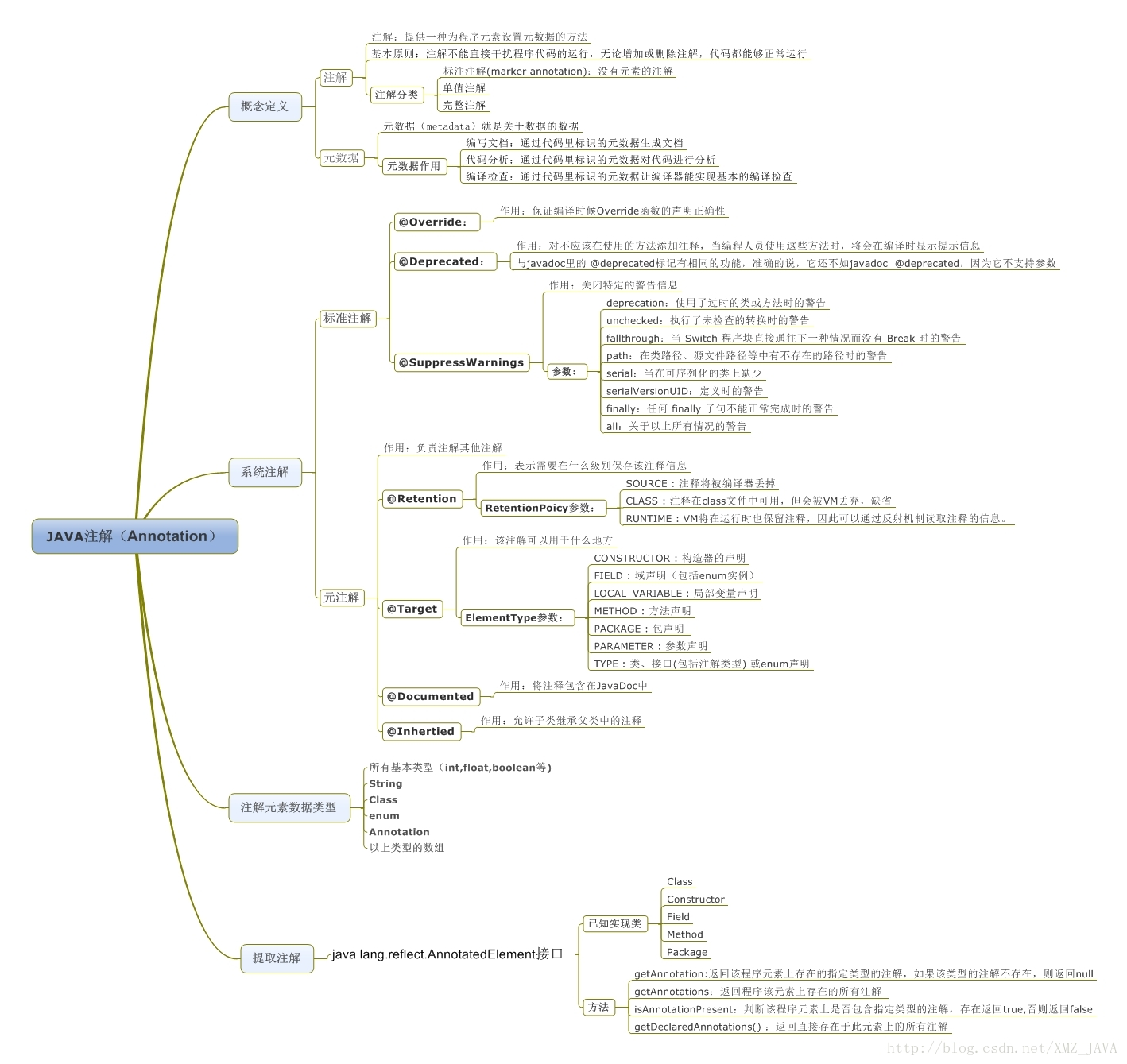本文从csdn迁移过来,作为博客园的第一篇文章,今后的博客都会到博客园记录文章
要深入学习注解,我们就必须能定义自己的注解,并使用注解,在定义自己的注解之前,我们就必须要了解Java为我们提供的元注解和相关定义注解的语法。
1 package annotation; 2 3 import static java.lang.annotation.ElementType.METHOD; 4 import static java.lang.annotation.RetentionPolicy.RUNTIME; 5 6 import java.lang.annotation.Documented; 7 import java.lang.annotation.ElementType; 8 import java.lang.annotation.Retention; 9 import java.lang.annotation.RetentionPolicy; 10 import java.lang.annotation.Target; 11 /** 12 * 13 * @author Minzhe Xu 2017年4月27日下午3:22:52 14 * 15 *@Target 表示该注解用于什么地方,可能的值在枚举类 ElemenetType 中,包括: 16 *ElemenetType.CONSTRUCTOR:构造器声明 17 *ElemenetType.FIELD :域声明(包括 enum 实例) 18 *ElemenetType.LOCAL_VARIABLE:局部变量声明 19 *ElemenetType.METHOD :方法声明 20 *ElemenetType.PACKAGE :包声明 21 *ElemenetType.PARAMETER :参数声明 22 *ElemenetType.TYPE:类,接口(包括注解类型)或enum声明 23 * 24 *@Retention 表示在什么级别保存该注解信息。可选的参数值在枚举类型 RetentionPolicy 中,包括: 25 *RetentionPolicy.SOURCE :注解将被编译器丢弃 26 *RetentionPolicy.CLASS :注解在class文件中可用,但会被VM丢弃 27 *RetentionPolicy.RUNTIME VM:将在运行期也保留注释,因此可以通过反射机制读取注解的信息。 28 * 29 *@Documented 将此注解包含在 javadoc 中 ,它代表着此注解会被javadoc工具提取成文档。在doc文档中的内容会因为此注解的信息内容不同而不同。相当与@see,@param 等。 30 * 31 *@Inherited 允许子类继承父类中的注解。 32 */ 33 34 @Target({ElementType.TYPE,ElementType.CONSTRUCTOR,ElementType.METHOD,ElementType.PARAMETER,ElementType.FIELD}) 35 @Retention(RetentionPolicy.RUNTIME) 36 public @interface TestA { 37 38 /** 39 * @interface用来声明一个注解, 40 * 其中的每一个方法实际上是声明了一个配置参数。 41 * 方法的名称就是参数的名称,返回值类型就是参数的类型(返回值类型只能是基本类型、Class、String、enum)。 42 * 可以通过default来声明参数的默认值。 43 */ 44 String name(); 45 int id() default 0; 46 Class gid(); 47 48 }
测试类
1 package annotation; 2 3 import java.util.HashMap; 4 import java.util.Map; 5 6 /** 7 * 8 * @author Minzhe Xu 2017年4月27日下午3:09:20 9 * 10 */ 11 @TestA(gid = Long.class, name = "type") 12 public class UserAnotation { 13 @TestA(gid = Long.class, name = "param",id=1) 14 private Integer age; 15 16 @TestA(gid = Long.class, name = "constract",id=2) 17 public UserAnotation(){ 18 19 } 20 @TestA(gid = Long.class, name = "method",id=3) 21 public void test1(){ 22 @SuppressWarnings("rawtypes") 23 Map m=new HashMap(0); 24 } 25 26 @TestA(gid = Long.class, name = "method3",id=5) 27 public void test2(@TestA(gid = Long.class, name = "inner_param",id=4) Integer a){ 28 29 } 30 31 32 }
通过反射的方式 使用注解
package annotation; import java.lang.annotation.Annotation; import java.lang.reflect.Constructor; import java.lang.reflect.Method; /** * * @author Minzhe Xu 2017年4月27日下午3:39:17 * */ public class ParseAnotation { public static void parseTypeAnnotation() throws ClassNotFoundException{ Class clazz=Class.forName("annotation.UserAnotation"); Annotation[] annotations = clazz.getAnnotations(); for(Annotation annotation:annotations){ TestA testA=(TestA) annotation; System.out.println("id="+testA.id()+";name="+testA.name()+";gid="+testA.gid()); } } public static void parseMethodAnnotation(){ Method[] methods = UserAnotation.class.getDeclaredMethods(); for(Method method:methods){ boolean hasAnnotation=method.isAnnotationPresent(TestA.class); if(hasAnnotation){ TestA testA=method.getAnnotation(TestA.class); System.out.println("id="+testA.id()+";name="+testA.name()+";gid="+testA.gid()); } } } @SuppressWarnings("unchecked") public static void parseConstractAnnotation(){ Constructor[] constructors = UserAnotation.class.getConstructors(); for(Constructor contructor:constructors){ boolean annotationPresent = contructor.isAnnotationPresent(TestA.class);//isAnnotationPresent方法来判断是否使用了某个注解 if(annotationPresent){ TestA testA = (TestA) contructor.getAnnotation(TestA.class); System.out.println("id="+testA.id()+";name="+testA.name()+";gid="+testA.gid()); } } } public static void main(String[] args) throws ClassNotFoundException { parseTypeAnnotation(); parseMethodAnnotation(); parseConstractAnnotation(); } }
